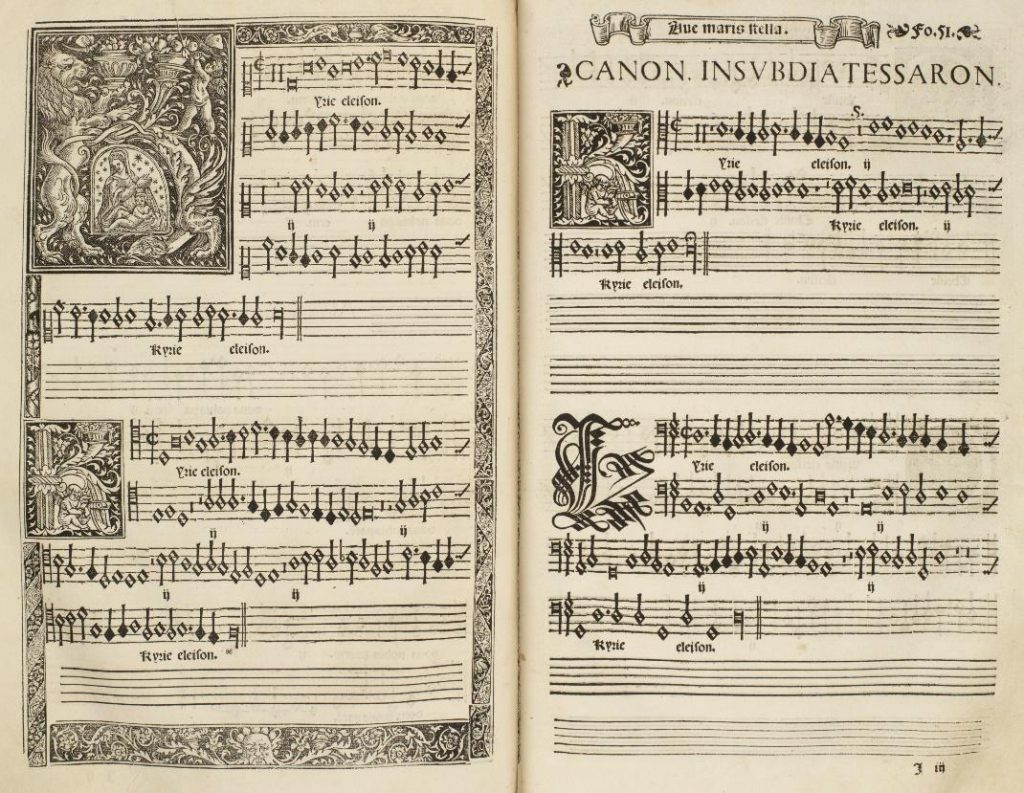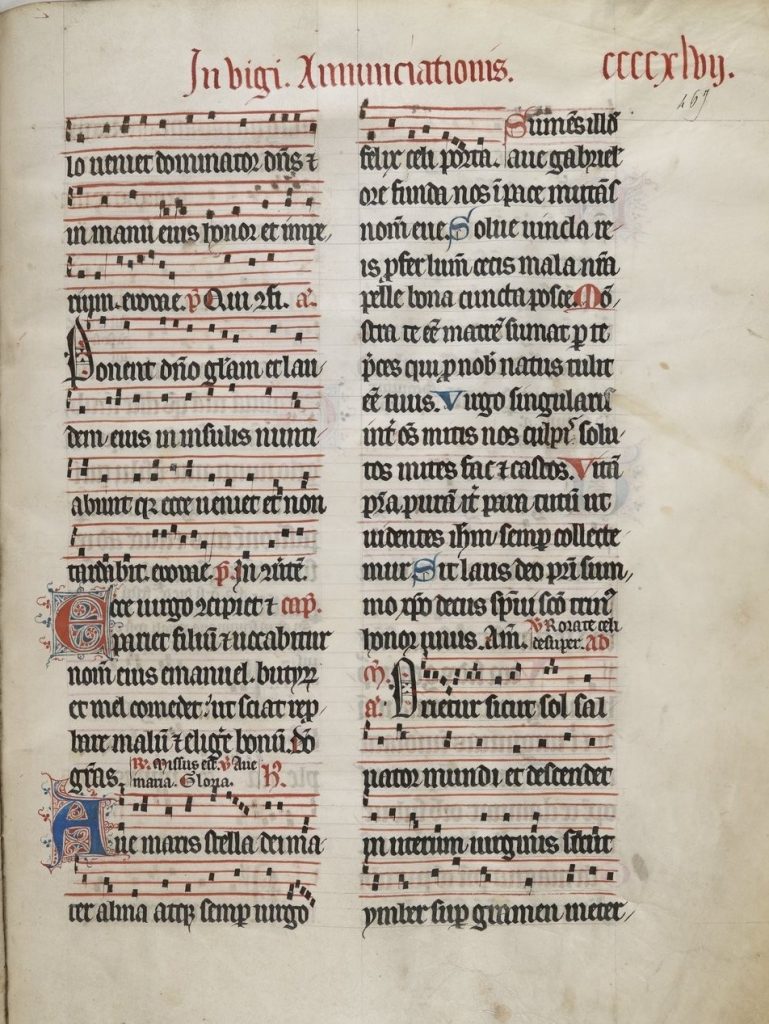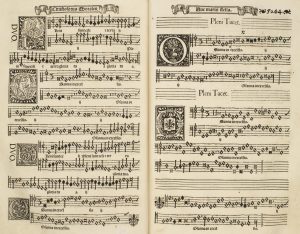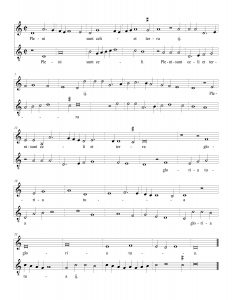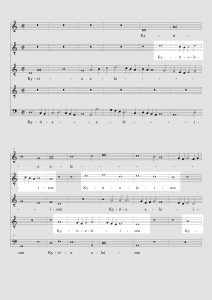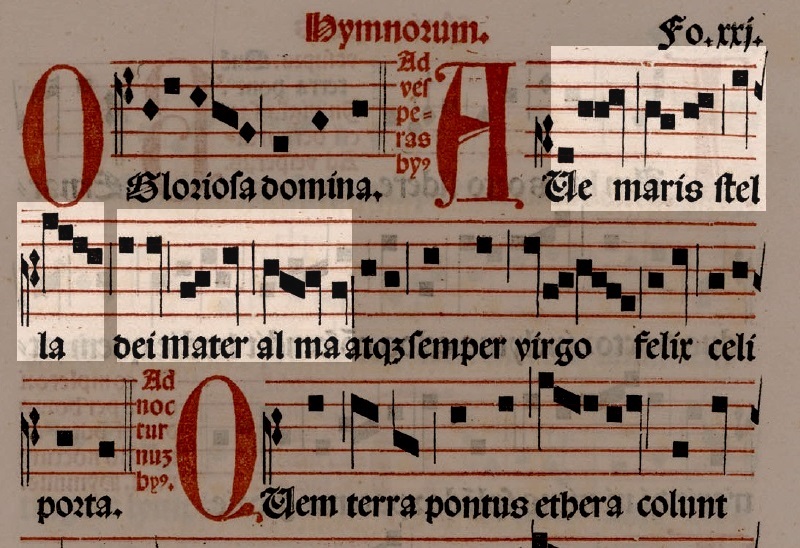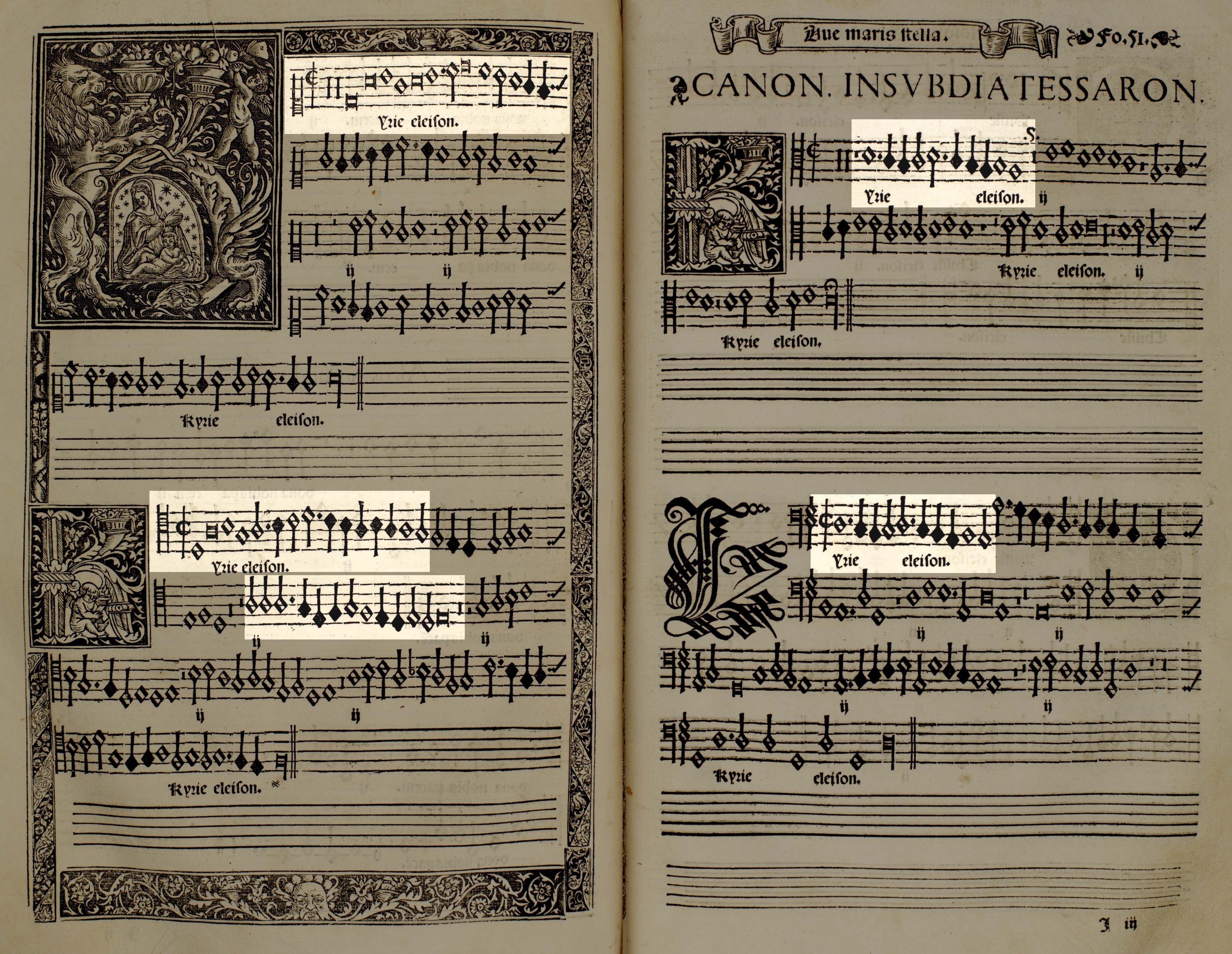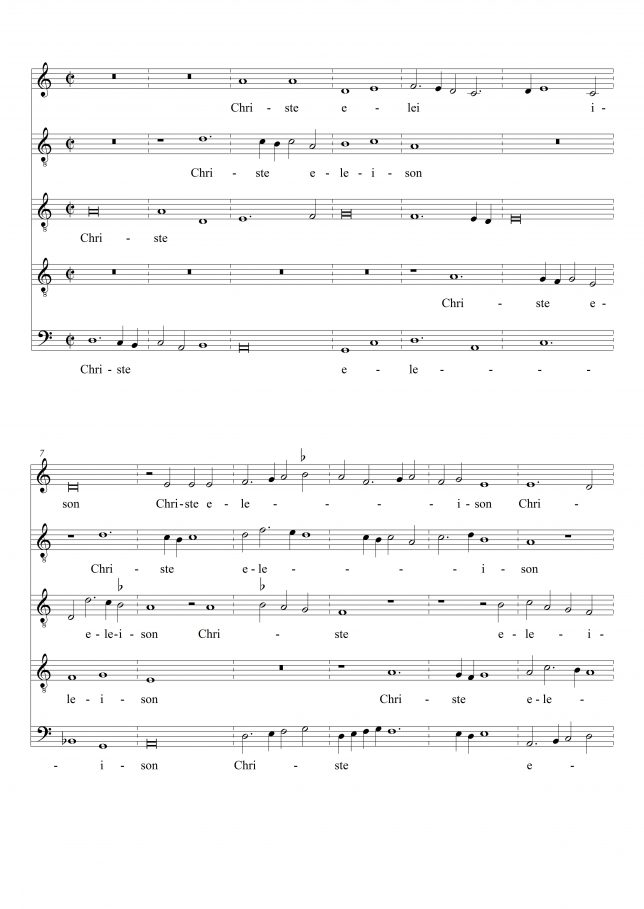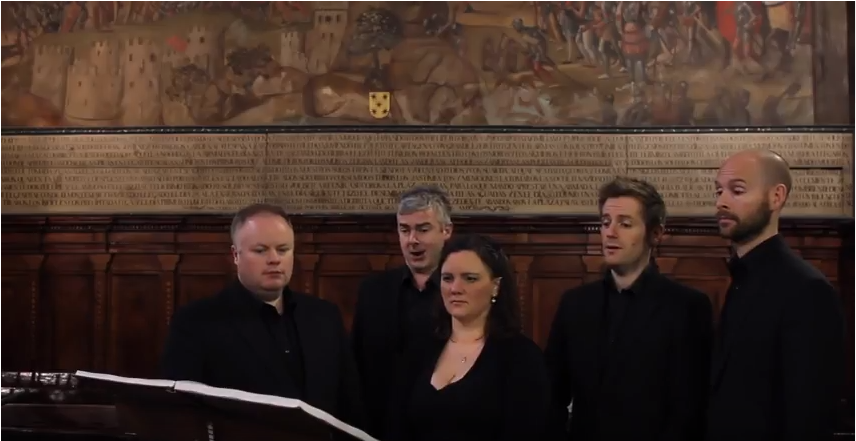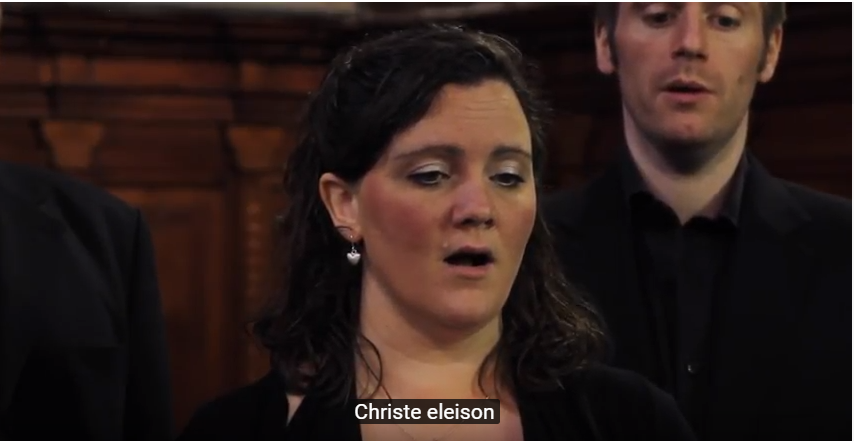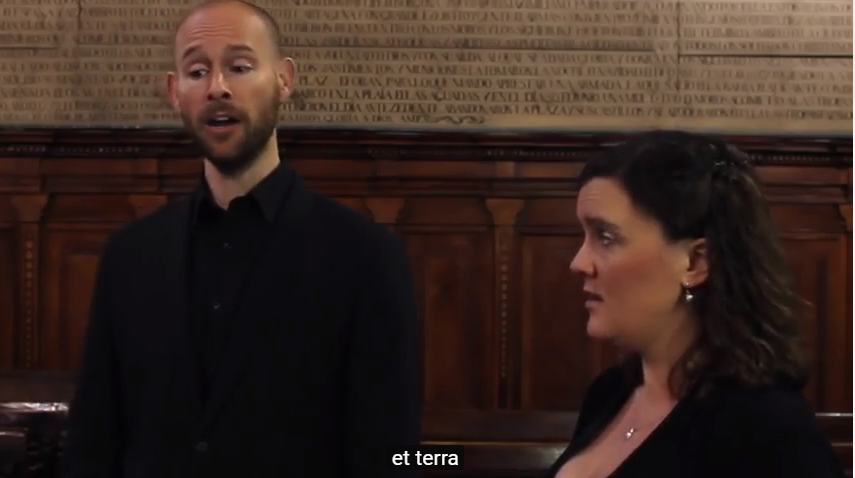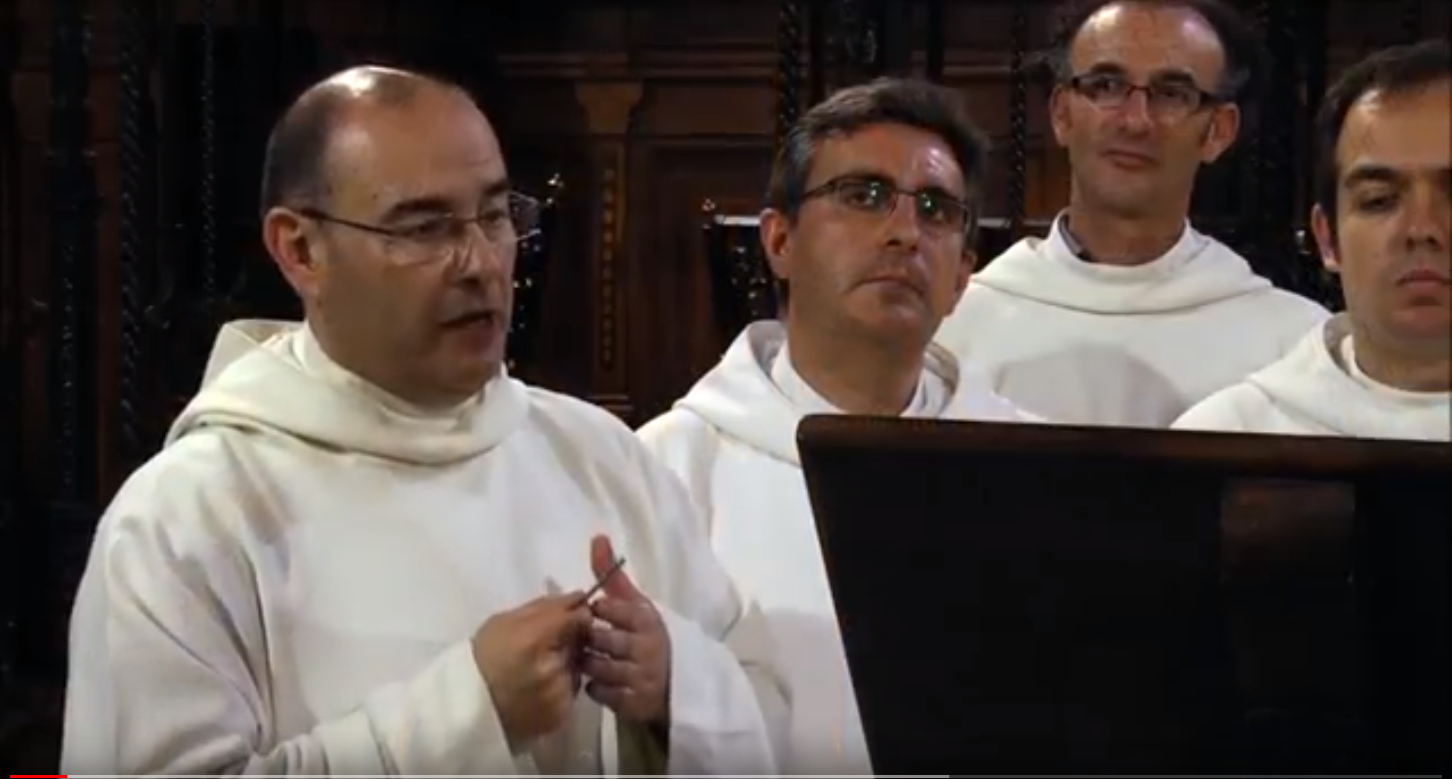Morales based his Missa Ave maris stella, the first opening of which is illustrated above, on the melody of one of the most widely known medieval plainsong hymns to the virgin Mary.
An anonymous poet composed the words of the hymn in perhaps the 11th century. They comprise short stanzas of four six-syllable lines. The opening two stanzas (or verses) follow:
Ave maris stella
Dei mater alma
Atque semper virgo
Felix caeli porta
(Hail, star of the sea, God’s own mother, and ever virgin, heaven’s happy portal)
Sumens illud Ave
Gabrielis ore
funda nos in pace
mutans Evæ nomen
(Hearing that “Ave,” from Gabriel’s mouth, confirm us in peace, the name of “Eva” transformed)
During the first half of the second millennium, Ave maris stella was sung regularly in cathedrals, churches, chapels, convents, and monasteries throughout Western Europe. In particular, the hymn was performed at the evening service of Vespers on such major annual Marian feasts as the Annunciation (on 25 March), and the Assumption (15 August).
Hundreds of manuscript copies of the words and the well-known melody survive from the 1300s and 1400s (such as the one pictured above, in a 13th-century breviary from Paris), and though many smaller details of the tune vary from manuscript to manuscript, the melody’s basic outline assures that it is immediately recognizable.
Among the earliest printed sources of the hymn are several from Morales’s native Spain. In the Toledo hymnary pictured below, published in 1515, the melody is printed with the words of the first verse only. The hymn is sung here by Spanish plainsong specialists Schola Antiqua under the direction of Juan Carlos Asensio Palacios.

Morales’s Missa Ave maris stella (5vv)
By virtue of its melodic characteristics and distinct structure, the plainsong hymn Ave maris stella provided Morales, just as it had done for with Josquin decades earlier, with a melodic as well as a formal model upon which he based his polyphonic mass. Additionally, Morales was also very conscious of Josquin’s compositional technique and, at times, borrowed from Josquin’s borrowing procedures in his own Missa Ave maris stella. Any analysis of Morales’s mass will thus involve our tracing the disposition and ordering of the borrowed material, both monophonic and polyphonic, within the new composition. One of the fascinating characteristics of Morales’s mass is that he wrote a canon into every movement of his mass, sharing it always between altus and tenor II and placing it uniformly at the lower fourth. He was so adroit with this canonic procedure that he even employed the hymn melody itself as a canonic subject in the Sanctus. The hymn melody also appears as a cantus firmus, sung by the cantus I, in the final Agnus Dei. We might speculate that Morales’s decision to write canons into every movement of this mass was prompted by Josquin who, in the Agnus Dei of his Missa Ave maris stella, has the bassus and tenor join in a canon at the fifth, followed by the altus and superius in a canon at the fourth, and finally the tenor and superius singing a canon at the octave.
Morales also employs the so-called head-motif, that is, a literal quotation of the hymn’s opening phrase, at the opening of all of the principal and most of the subsidiary movements of his mass. In the paragraphs that follow, we consider some of the shorter movements of the Missa Ave maris stella.
Pleni sunt caeli (duo)
The first of the above illustrations shows the second double-page opening of the Sanctus movement of the mass in the Burns Library’s Morales choirbook. It gives music for both the duo Pleni sunt caeli, and the full 5-voice Osanna in excelsis that follows it.
The second of the above illustrations highlights the sectors of the two pages upon which the music for the Pleni sunt caeli is printed. On the left hand page of the second illustration, the highlighted soprano (top) and tenor (bottom) are provided the musical notation from which they sing the duo Pleni sunt caeli itself. On the right hand page, the alto and bass voices are instructed to remain silent by the Latin rubric ‘Pleni tacet’.
As a whole, Morales’s Ave maris stella mass can be thought of as a set of variations on the hymn. However, in the course of Morales’s polyphonic mass, the melody itself—the theme—is never heard complete in its simple original plainsong form. Rather, the composer separates out the four individual lines or phrases of the tune and re-arranges and combines them contrapuntally in new and ingenious ways.
The short Pleni Sunt Caeli is, in fact, one of the rare sections of the mass in which Morales employs all four phrases of the tune.
The video below shows, first, the four phrases of the plainsong melody (numbered 1-4), and, second, the corresponding points where references to these four phrases occur and recur in Morales’s duo. As can be seen, the upper voice part in the duo (soprano) features two references to phrase 2, and one each to phrases 3 and 4. The lower voice part (tenor) actually begins quoting phrase 1 of the original plainsong melody almost exactly, and then makes reference to phrases 2 (three times), 3, and 4.
(Play the clip below to see these phrases highlighted.)
For other sections of the mass, and in stark contrast with the Pleni sunt caeli, Morales concentrated on only one or two chosen phrases from the Ave maris stella chant, as is the case in the Christe section of the Kyrie movement to be discussed below.
Kyrie I (canon)
 Morales commences his Ave Maris Stella mass by deploying all five voices in the first section of the Kyrie I . A casual glance at the double-page opening, shown above, might lead the singers to suppose that the composer supplied music for only four voices: soprano (top left), alto (top right), tenor (bottom left), and bass (bottom right). But the added inscription CANON IN SVBDIATESSARON above the alto (top right of page) indicates that a fifth voice is called for. This fifth voice participates in a canon with the alto, singing the same music, but starting a little later, at the small “.s.” sign, or signum highlighted in the illustration below. The fifth voice is further instructed to sing at a lower pitch “in sub diatessaron,” that is, at the melodic interval of a fourth lower than the notated pitch.
Morales commences his Ave Maris Stella mass by deploying all five voices in the first section of the Kyrie I . A casual glance at the double-page opening, shown above, might lead the singers to suppose that the composer supplied music for only four voices: soprano (top left), alto (top right), tenor (bottom left), and bass (bottom right). But the added inscription CANON IN SVBDIATESSARON above the alto (top right of page) indicates that a fifth voice is called for. This fifth voice participates in a canon with the alto, singing the same music, but starting a little later, at the small “.s.” sign, or signum highlighted in the illustration below. The fifth voice is further instructed to sing at a lower pitch “in sub diatessaron,” that is, at the melodic interval of a fourth lower than the notated pitch.
The illustrations below show the opening of the canon in the original notation with the first two phrases marked, and the same phrases highlighted in the two voices in the modern full score.
Before these two voices begin their canon, however, Morales opens the mass by giving prominent attention to the signature first phrase of his hymn theme, heard first in the tenor voice at the outset, and repeated (or answered) an octave higher by the soprano. The tenor refers next to the second phrase of the plainsong hymn melody, while the opening phrase of the canonic voice parts also make reference to the same phrase.
Christe eleison (canon)
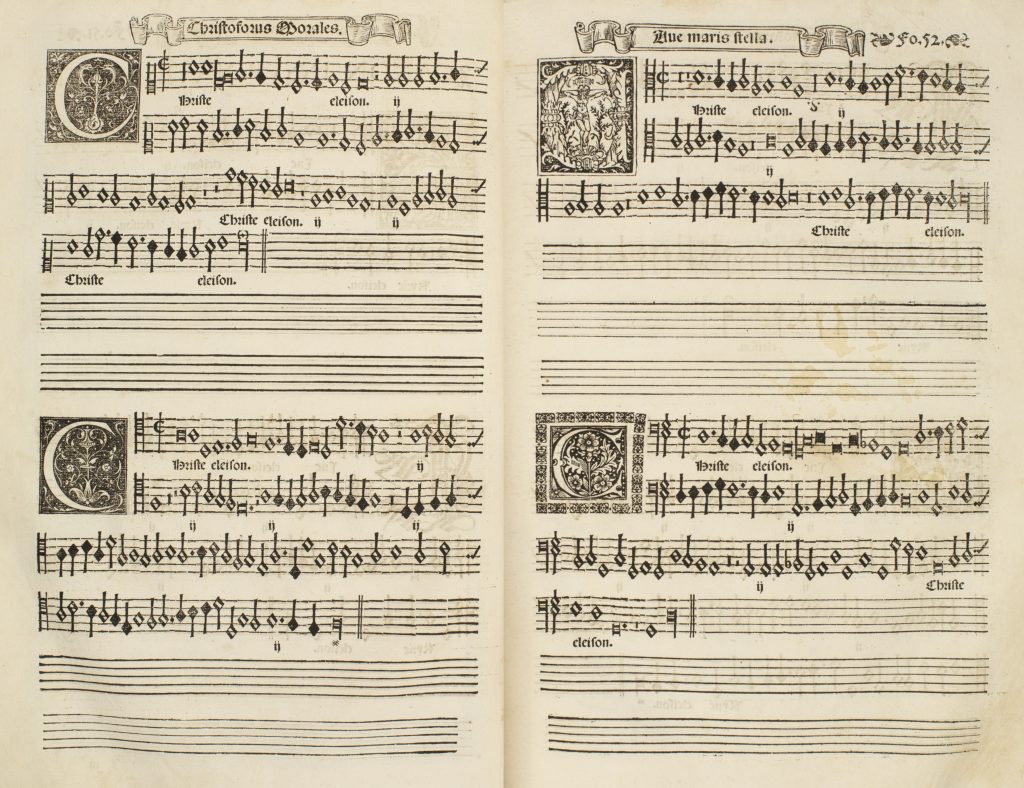 In the Christe eleison that follows, the original notation (see above) appears, at first glance, to supply music for only four voice parts. But, again, the lower case “.s.” under the middle of the top staff on the right-hand page indicates that the composer requires a fifth voice, which (though Morales omits this time to specify it) continues to sing a fourth below the leading voice (“in sub diatessaron”).
In the Christe eleison that follows, the original notation (see above) appears, at first glance, to supply music for only four voice parts. But, again, the lower case “.s.” under the middle of the top staff on the right-hand page indicates that the composer requires a fifth voice, which (though Morales omits this time to specify it) continues to sing a fourth below the leading voice (“in sub diatessaron”).
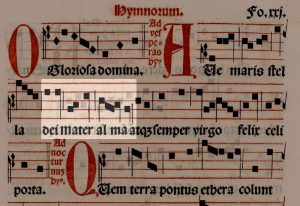 At the opening of this section, Morales refers to the second phrase of the plainsong hymn (see the melodic phrase underlaid with the text Dei mater alma and highlighted in the illustration above). Slightly elaborated versions of this second phrase are sung first by the tenor voice (left bottom in the original), and then by the soprano (left top). Meanwhile, the opening phrases of the canonic voices and the bass sing a shorter variation on just the end of the second phrase. At a structural level, Morales’s employment of the second phrase of the hymn for the beginning of the second movement of his mass reveals a sophisticated formal plan.
At the opening of this section, Morales refers to the second phrase of the plainsong hymn (see the melodic phrase underlaid with the text Dei mater alma and highlighted in the illustration above). Slightly elaborated versions of this second phrase are sung first by the tenor voice (left bottom in the original), and then by the soprano (left top). Meanwhile, the opening phrases of the canonic voices and the bass sing a shorter variation on just the end of the second phrase. At a structural level, Morales’s employment of the second phrase of the hymn for the beginning of the second movement of his mass reveals a sophisticated formal plan.
A little later in the Christe, Morales makes somewhat less obvious references to other phrases of the hymn. But as the music of this short movement proceeds, he makes less and less of its plainsong tune, reveling instead in the free contrapuntal interchange of the five polyphonic voices.

